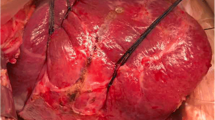Abstract
Background
Hepatolithiasis is a postoperative complication of hepaticojejunostomy (HJ) performed for various pancreatobiliary diseases. Hepatolithiasis can cause repeated cholangitis. Complete stone removal and bile stasis elimination are therefore necessary. Here, we evaluated the effectiveness of peroral direct cholangioscopy (PDCS) using an ultraslim endoscope for treating hepatolithiasis in HJ patients.
Methods
We studied 14 patients with hepatolithiasis who underwent bowel reconstruction with HJ between April 2012 and May 2014. Diagnostic and therapeutic endoscopic retrograde cholangiography using a short double-balloon enteroscope (DBE) was initially performed. Following stone removal, the DBE was exchanged for an ultraslim endoscope through the balloon overtube for PDCS.
Results
The success rate of PDCS procedure was 85.7 % (12/14). In 5 of 12 (41.7 %) patients with successful PDCS, the residual stones were detected and removed completely using a 5-Fr basket catheter and suction after normal saline irrigation. In the remaining 7 (58.3 %) patients, no residual stone was detected. The median procedure time was 14 min (range 8–36) with no serious postoperative complications. The median follow-up time after PDCS was 21 months (range 5–26), and only 1 patient (8.3 %) had IHBD stone recurrence with an anastomotic stricture.
Conclusions
PDCS using an ultraslim endoscope appears to be useful for detecting and removing residual stones following hepatolithiasis treatment using a DBE. The combined use of a DBE and PDCS may reduce the risk of hepatolithiasis recurrence in HJ patients.



Similar content being viewed by others
References
Cheon YK, Cho YD, Moon JH, Lee JS, Shim CS (2009) Evaluation of long-term results and recurrent factors after operative and nonoperative treatment for hepatolithiasis. Surgery 146:843–853
Tsutsumi K, Kato H, Muro S, Yamamoto N, Noma Y, Horiguchi S, Harada R, Okada H, Yamamoto K (2014) ERCP using a short double-balloon enteroscope in patients with prior pancreatoduodenectomy: higher maneuverability supplied by the efferent-limb route. Surg Endosc. doi:10.1007/s00464-014-3889-8
Sakakihara I, Kato H, Muro S, Noma Y, Yamamoto N, Harada R, Horiguchi S, Tsutsumi K, Okada H, Yamamoto K, Sadamori H, Yagi T (2014) Double-balloon enteroscopy for choledochojejunal anastomotic stenosis after hepato-biliary–pancreatic operation. Dig Endosc. doi:10.1111/den.12332
Shimatani M, Matsushita M, Takaoka M, Koyabu M, Ikeura T, Kato K, Fukui T, Uchida K, Okazaki K (2009) Effective “short” double-balloon enteroscope for diagnostic and therapeutic ERCP in patients with altered gastrointestinal anatomy: a large case series. Endoscopy 41:849–854
Takaoka M, Shimatani M, Ikeura T, Koyabu M, Kusuda T, Fukata N, Matsushita M, Okazaki K (2009) Diagnostic and therapeutic procedure with a short double-balloon enteroscope and cholangioscopy in a patient with acute cholangitis due to hepatolithiasis. Gastrointest Endosc 70:1277–1279
Itoi T, Sofuni A, Itokawa F, Kurihara T, Tsuchiya T, Ishii K, Ikeuchi N, Moriyasu F, Kasuya K, Tsuchida A, Kamisawa T, Baron TH (2012) Diagnostic and therapeutic peroral direct cholangioscopy in patients with altered GI anatomy (with video). Gastrointest Endosc 75:441–449
Koshitani T, Matsuda S, Takai K, Motoyashi T, Nishikata M, Yamashita Y, Kirishima T, Yoshinami N, Shintani H, Yoshikawa T (2012) Direct cholangioscopy combined with double-balloon enteroscope-assisted endoscopic retrograde cholangiopancreatography. World J Gastroenterol 18:3765–3769
Itoi T, Sofuni A, Itokawa F, Shinohara Y, Moriyasu F, Tsuchida A (2010) Evaluation of residual bile duct stones by peroral cholangioscopy in comparison with balloon-cholangiography. Dig Endosc 22:S85–S89
Bonnel DH, Fingerhut AL (2012) Percutaneous transhepatic balloon dilatation of benign bilioenteric strictures: long-term results in 110 patients. Am J Surg 203:675–683
Glas L, Courbiere M, Ficarelli S, Milot L, Mennesson N, Pilleul F (2008) Long-term outcome of percutaneous transhepatic therapy for benign bilioenteric anastomotic strictures. J Vasc Interv Radiol 19:1336–1343
Fontein DB, Gibson RN, Collier NA, Tse GT, Wang LL, Speer TG, Dowling R, Robertson A, Thomson B, de Roos A (2011) Two decades of percutaneous transjejunal biliary intervention for benign biliary disease: a review of the intervention nature and complications. Insights Imaging 2:557–565
Author information
Authors and Affiliations
Corresponding author
Ethics declarations
Disclosures
Kazuyuki Matsumoto, Koichiro Tsutsumi, Hironari Kato, Yutaka Akimoto, Daisuke Uchida, Takeshi Tomoda, Naoki Yamamoto, Yasuhiro Noma, Shigeru Horiguchi, Hiroyuki Okada and Kazuhide Yamamoto have no conflicts of interest to disclose.
Electronic supplementary material
Below is the link to the electronic supplementary material.
The DBE was exchanged for an ultraslim endoscope leaving the overtube with its balloon inflated. The ultraslim endoscope was advanced through the balloon overtube up to the hepaticojejunostomy anastomosis and was directly inserted into the intrahepatic bile duct. Residual stones were detected and extracted using a 5-Fr basket catheter and suction after normal saline irrigation (WMV 7298 kb)
Rights and permissions
About this article
Cite this article
Matsumoto, K., Tsutsumi, K., Kato, H. et al. Effectiveness of peroral direct cholangioscopy using an ultraslim endoscope for the treatment of hepatolithiasis in patients with hepaticojejunostomy (with video). Surg Endosc 30, 1249–1254 (2016). https://doi.org/10.1007/s00464-015-4323-6
Received:
Accepted:
Published:
Issue Date:
DOI: https://doi.org/10.1007/s00464-015-4323-6




